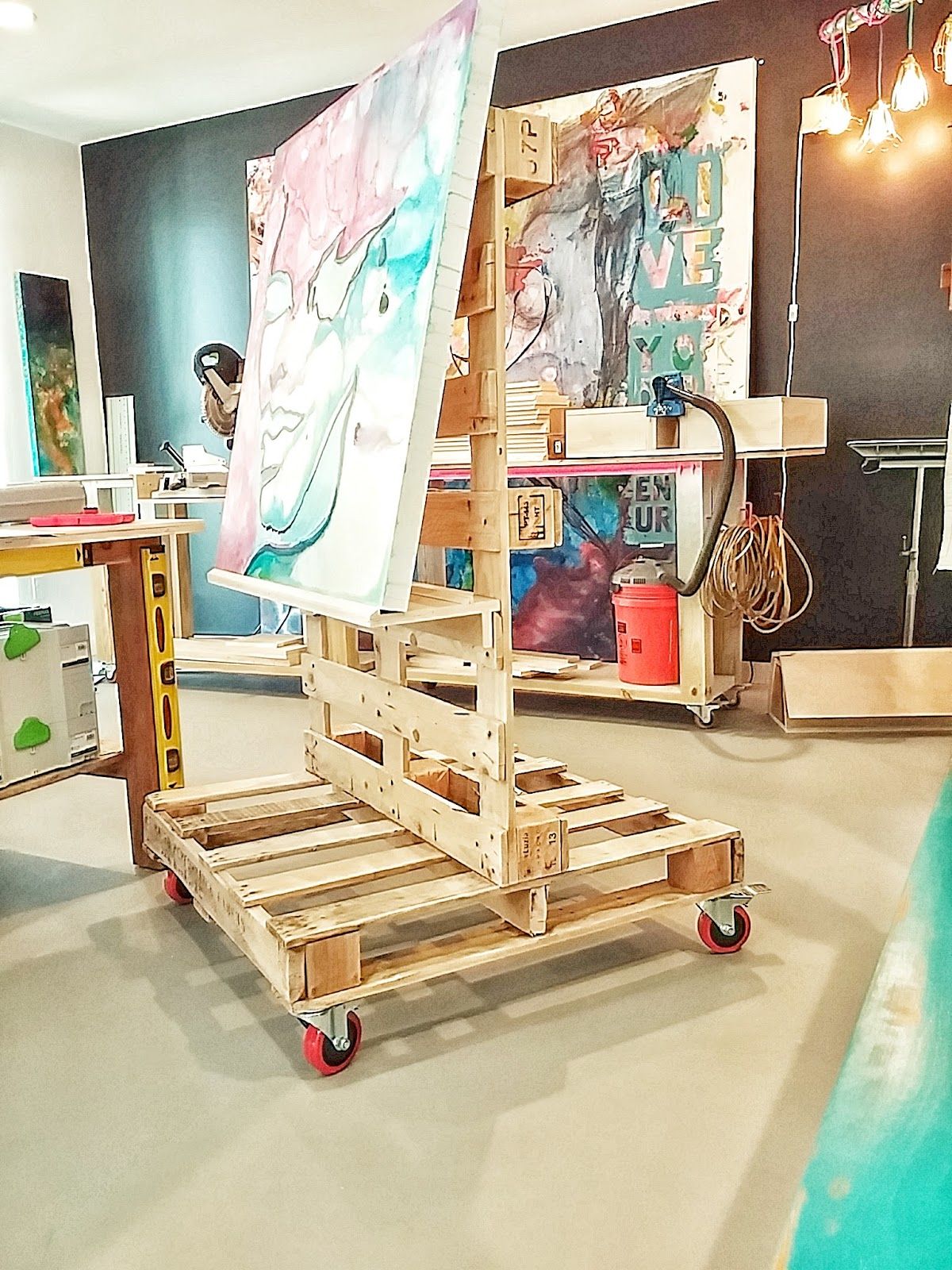Attention, artists of all kinds! It’s time to turn your creative dreams into a reality by designing a captivating art studio that nurtures your imagination. Whether you have a dedicated room or just a small corner to spare, this guide provides the tricks and tips you need to create a space that sparks your creativity and makes your artistic endeavors shine!
Functional Art Studio Plans
Dreaming of your own art studio can feel daunting, especially if you’re working with limited space. But don’t worry – with a little planning and creativity, you can transform any area into an inspiring and functional art haven.
Key Considerations for Your Art Studio:
- Space: Assess the available space, considering both floor area and wall space. Even a small corner can be transformed into a functional studio.
- Storage: Prioritize storage solutions that maximize vertical space, such as shelves, pegboards, and cabinets. Clear containers and labeling help maintain organization.
- Lighting: Natural light is ideal for art studios. Position your work area near a window and supplement with task lighting for specific tasks.
- Furniture: Invest in a comfortable and ergonomic chair to support long hours of creating. An adjustable work table can adapt to different projects.
- Inspiration: Infuse your studio with personality by adding pops of color, inspiring artwork, and elements that spark your creativity.
- Sustainability: Opt for eco-friendly materials and energy-efficient lighting whenever possible.
Here’s a handy table to keep in mind as you plan:
| Feature | Considerations |
|---|---|
| Storage | Vertical shelving, pegboards, rolling carts, clear containers for easy visibility |
| Lighting | Maximize natural light, task lighting for specific work areas |
| Furniture | Ergonomic chair, adjustable work table, comfortable seating for breaks |
| Inspiration | Mood boards, artwork displays, personal touches |
| Sustainability | Eco-friendly materials, energy-efficient lighting, repurposed furniture |
Remember, a truly functional art studio is an extension of your creative spirit – a space designed with intention, where inspiration flows freely.
How to Design a Functional Art Studio: Your Ultimate Guide
Ready to take your art space to the next level? This guide breaks down the process of crafting a studio that is both practical and inspiring.
1. Finding Your Creative Corner
- Dedicated Space: Choose a dedicated area for your studio, even if it’s just a corner of a room. This could be a spare bedroom, a section of the garage, or even a shed with proper modifications.
- Natural Light: Prioritize natural light as much as possible. Large windows are ideal, but even smaller windows can provide a mood boost.
- Ventilation: Ensure adequate ventilation, especially if you work with paints, solvents, or other materials that produce fumes.
2. Taming the Supply Beast
- Storage Solutions: Utilize a variety of storage solutions to keep supplies organized and accessible. This might include:
- Vertical Storage: Shelves, drawers, cabinets, pegboards
- Clear Containers: Easy visibility and organization.
- Labels: Clearly label everything to prevent frantic searches.
- Organization System: Choose an organization system that works for you, whether it’s by color, medium, project, or frequency of use.
3. Creating a Flow That Works
- Workflow Analysis: Consider your creative process and how you move about your workspace.
- Accessibility: Position frequently used tools and materials within easy reach.
- Open Space: Ensure enough open floor space for movement and stepping back to view your work.
4. Setting the Mood for Masterpieces
- Natural Light: Maximize natural light to enhance mood and reduce eye strain.
- Color Palette: Choose a color palette that promotes creativity and focus. Calming blues, greens, and neutrals can be soothing.
- Personal Touches: Infuse the space with personality – inspiring artwork, plants, music, or anything that sparks joy and creativity.
5. Making it Uniquely Yours
- Personal Style: Don’t be afraid to express your artistic style throughout your studio.
- Artwork Display: Display artwork that inspires you, whether it’s your own creations or pieces by artists you admire.
- Collections: Incorporate personal collections or items that reflect your interests.
Key Takeaways to Remember
- Space is Precious: Use clever storage solutions to maximize every inch.
- Let There Be Light (and Air): Natural light and good ventilation are your best friends.
- Infuse Your Style: Make your studio a reflection of your unique artistic voice.
- Work Smarter, Not Harder: Design a layout that optimizes your workflow and keeps you in the creative zone.
- Respect Mother Nature: Choose eco-friendly materials and practices whenever possible.
Small Art Studio Ideas: Maximizing Space for Creativity
Don’t let limited space stifle your artistic dreams! With some ingenuity, you can transform even the tiniest nook into a vibrant art haven.
Space-Saving Strategies:
- Embrace Verticality: Utilize wall-mounted shelving, pegboards, and grid panels to maximize vertical storage and free up valuable floor space.
- Adaptable Furniture: Opt for furniture that can adapt to your needs, such as foldable tables, stackable chairs, or storage ottomans.
- Versatile Display Systems: Explore magnetic walls, adjustable shelves, or cable systems to create flexible and adaptable art displays.
Creating a Dedicated Zone:
- Defined Area: Even without walls, you can create a designated creative zone within a shared space. Use room dividers, curtains, or even strategic furniture placement to delineate the area.
- Visual Separation: Use rugs, lighting, or color to visually separate your studio space from the rest of the room.
Prioritizing Light and Air:
- Natural Light: Make the most of natural light by positioning your workspace near a window. If natural light is limited, consider adding a skylight or using mirrors to reflect light.
- Ventilation: Ensure proper ventilation to prevent the buildup of fumes from art materials. Open windows when possible, use fans, or consider installing an air purifier.
Here’s a handy table to summarize our space-saving secrets:
| Solution | Benefits |
|---|---|
| Wall-mounted shelves | Maximize vertical storage, free up floor space |
| Pegboards/grid panels | Organize tools and artwork, keep them visible and accessible |
| Foldable furniture | Adaptable to changing needs, conserves space |
| Versatile display systems | Easy to rearrange artwork, showcase different pieces |
| Dedicated creative zone | Fosters focus, separates art-making from distractions |
| Natural light | Reduces eye strain, enhances mood and productivity |
| Good ventilation | Removes odors and fumes, maintains a healthy environment |
Art Studio Storage Solutions: Organizing Your Creative Haven
A well-organized studio is crucial for a productive and enjoyable creative process. These storage solutions will help you conquer clutter and keep your art supplies in check.
Think Vertical:
- Floating Shelves: Perfect for displaying finished artwork, storing art books, or keeping frequently used supplies within reach.
- Wall-Mounted Organizers: Utilize baskets, hooks, clips, and other attachments to create a customized organization system on your wall.
- Vertical Drawer Systems: Ideal for storing larger items, tools used less frequently, or supplies that need to be protected from dust and light.
Get Your Supplies in Order:
- Designated Storage Areas: Create zones within your studio for different activities, such as a painting corner, a drawing station, or a sculpting area.
- Drawer Dividers and Bins: Utilize drawer dividers, bins, and trays to separate and organize supplies by type, color, or project.
- Pegboards: Create a customizable storage wall with hooks, shelves, and containers.
Tech to the Rescue:
- Digital Storage: Scan sketches, artwork, and reference images to free up physical space and create digital backups. Utilize cloud storage or external hard drives for organization.
- Inventory Tracking Apps: Use inventory apps to track your art supplies, preventing over-purchasing and making it easier to find what you need.
- Online Marketplaces: Explore online marketplaces for used art studio furniture, storage solutions, and supplies.
Comfort is Key:
- Within Reach: Position frequently used tools and materials within arm’s reach to minimize strain and interruptions.
- Adjustable Work Surfaces: Use adjustable tables or easels to ensure a comfortable working height for different tasks.
- Ergonomic Tools: Invest in ergonomic tools, such as brushes with comfortable grips, chairs with lumbar support, and anti-fatigue mats, to prevent discomfort and injury.
The Takeaway?
Your art studio should be a reflection of your creative spirit – a haven where you feel inspired and productive. By implementing these storage solutions, you can create a more efficient, organized, and enjoyable workspace.
Internal Links:
For a mezzanine office project, staying up-to-date on the building regulations application is crucial to ensure compliance. Explore the captivating designs and construction process of reveal pods, innovative modular spaces that offer flexibility and style to your art studio plans.
- How to Remove Water Stains from Fabric: A Complete Guide - April 26, 2025
- How to Get Motor Oil Out of Clothes: Proven Methods & Expert Tips - April 26, 2025
- How to Get Deodorant Out of Black Shirts: Easy Stain Removal Guide - April 26, 2025










